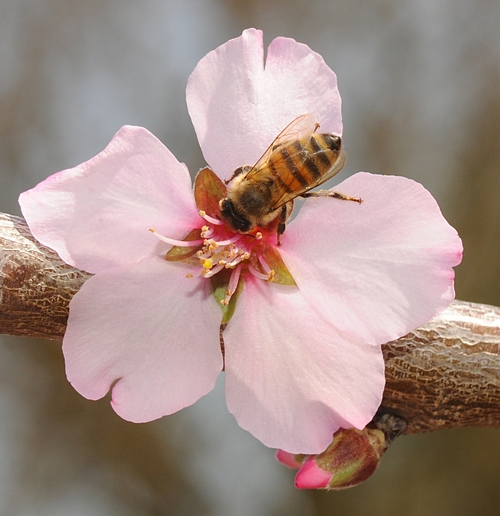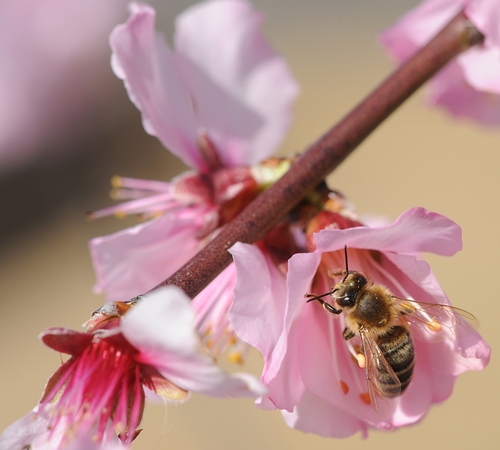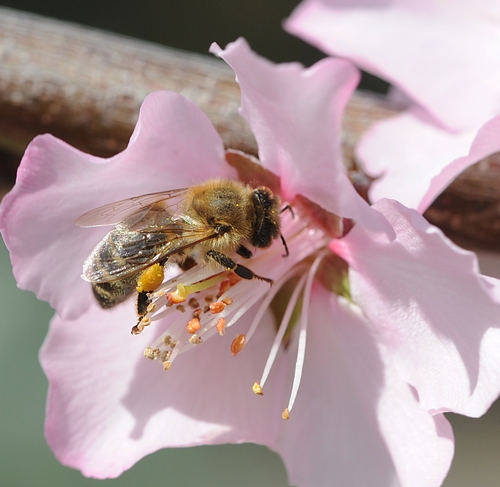- Author: Kathy Keatley Garvey

That's a short-cut for "Bee Best Management Practices."
The Almond Board of California today unveiled its long-awaited "Honey Bee Best Management Practices for California Almonds."
It's an important document because it is aimed at protecting the honey bees that pollinate California's 900,000 acres of almonds. Last spring some 80,000 colonies died because pesticides reached them before the beekeepers did, that is, before the beekeepers could remove them from the orchards after pollination season. It amounted to a lack of communication.
The editors spelled out the importance of the document at the onset:
"Honey bees are essential for successful pollination of almonds and the long-term health of the California Almond industry. Why should almond growers — and all parties involved in almond pollination — care about healthy, strong bees? First, bees are a valuable resource and almond production input, and the time they spend in almonds impacts hive health throughout the year, from the time they leave almond orchards until they return the next season. Second, although almonds are only one of more than 90 foods that rely on pollination by bees, because of its size and number of bees needed, the California Almond industry is increasingly being watched by the public on matters related to the health and stability of honey bee populations. Of particular concern at this time is how to manage the use of pest control materials in ways that minimize their possible impact on honey bees. It is important that growers of all crops implement best management practices to support bee health, and for those whose crops rely on honey bee pollination, to consider honey bee health not only during the pollination season, but during the entire year."
The Bee BMP zeroed in on four key precautions:
1. Maintain clear communication among all parties involved, particularly on the specifics of pesticide application.
2. If it is necessary to spray the orchard, for instance with fungicides, do so in the late afternoon or evening.
3. Until more is known, avoid tank-mixing products during bloom.
4. Avoid applying insecticides during bloom until more is known about the effects on honey bees, particularly to young, developing bees in the hive. Fortunately, there are several insecticide application timing options other than bloom time treatments.
The document advocates that a clear chain of communication be established among all parties involved in pollination and pest management during almond bloom. This should definitely help prevent bee losses before, during and after the pollination season.
Three officials from the Almond Board of California did an excellent job editing the document and drawing input from the industries:
- Bob Curtis, associate director, Agricultural Affairs
- Gabriele Ludwig, associate director, Environmental Affairs
- Danielle Veenstra, specialist, Agricultural and Environmental Affairs
They received input from 10 contributing editors and reviewers:
- Gene Brandi, Gene Brandi Apiaries
- Jackie Park-Burris, Jackie Park-Burris Queens
- Orin Johnson, Johnson Apiaries
- Gordon Wardell, director, Pollination Operations, Paramount Farming Company
- George Farnsworth, California Department of Pesticide Regulation
- Karen Francone, California Department of Pesticide Regulation
- Eric Mussen, Extension Apiculturist retired, UC Davis
- Thomas Steeger, Office of Pesticide Programs, U.S. EPA
- CropLife America
- Christi Heintz, Project Apis m.
You can download the document on the Almond Board of California website. (Look under "growers" at the top of the home page.)

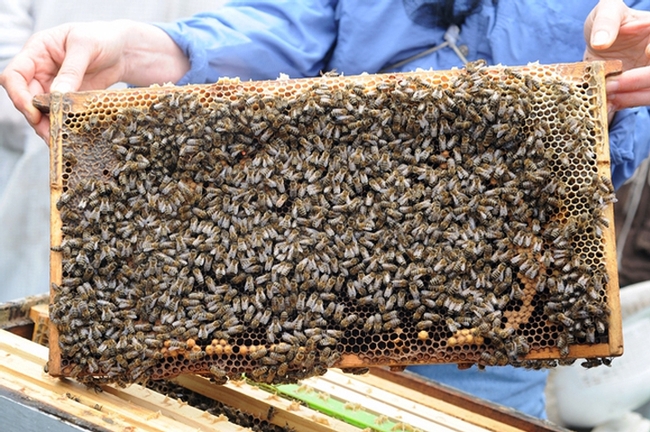
- Author: Kathy Keatley Garvey
The Almond Board of California will unveil its Honey Bee Best Management Practices tomorrow (Thursday, Oct. 16) in an ongoing effort to promote and protect bee health.
The board will do so by holding a press conference at 8:30 a.m. Pacific Time with questions directed at Richard Waycott, CEO, Almond Board of California; Bob Curtis, associate director of Agricultural Affairs, Almond Board of California and Extension apiculturist (retired) Eric Mussen of the UC Davis Department of Entomology and Nematology.
It promises to be a comprehensive set of Best Management Practices or BMPs.
Remember last spring when beekeepers in the San Joaquin Valley almond orchards reported losing 80,000 colonies? Beekeepers believe that pesticides killed their bees after the almond pollination season ended but just before they could move their bees to another site.
Mussen wrote about the issue in the March/April edition of his newsletter, from the UC apiaries, published on his website. We also blogged about it.
"When should the colonies be allowed to leave the orchards?" Mussen asked. "When pollination no longer is happening. That does not mean that the bees should remain in place until the last petal falls from the last blossom."
Communication is key to a good BMP. The Almond Board recently published three informational pieces, “Honey Bee Best Management Practices for California Almonds,” "Honey Bee Best Management Practices Quick Guide for Almonds,” and “Applicator/Driver Honey Bee Best Management Practices for Almonds” (in English and Spanish).
The topics include:
- Preparing for arrival
- Assessing hive strength and quality
- Protecting honey bees at bloom
- Honey bees and insecticides
- Honey bees and fungicides
- Using integrated pest management (IPM) strategies to minimize agricultural sprays
- Honey bees and self-compatible almond varieties
- Best management practices for pest control during almond bloom
- Removing honey bees from the orchard
- Addressing suspected pesticide-related honey bee losses
- What to expect in an investigation
The Bee Informed Partnership (BIP), headed by Dennis van Engelsdorp, produced three short videos as the result of a 2012-2013 beekeeping survey. Project Apis m (PAm) published some of the information online about varroa mites, nosema, honey bee nutrition and the like.
It's important for almond growers and beekeepers to keep the lines of communication open. Bees make a "bee line" toward the almond blossoms, but the growers and the beekeepers don't always make a timely "bee line" toward one another to resolve issues that surface.


- Author: Kathy Keatley Garvey
It's the Big 4-0 for the Almond Board of California's annual almond industry conference this week.
Some 1000 convention-goers are gathering in the Sacramento Convention Center. The 40th annual conference opened Tuesday, Dec. 11 and runs through Thursday, Dec. 13.
A contingent from the Department of Entomology at the University of California, Davis, is there--including some from chemical ecologist Walter Leal's lab and some from the Harry H. Laidlaw Jr. Honey Bee Research Facility.
Many came to hear U.S. Secretary of Agriculture Tom Vilsack.
After all, almonds are California's biggest export. With some 750,000 acres of almonds in production in the state, the National Agricultural Statistics Service is forecasting a record-breaking 2.10 billion meat pounds this year, valued at approximately $3 billion. Eighty-percent of the global supply of almonds is grown in California, and about 70 percent of California’s crop is marketed overseas.
Over at the Laidlaw facility, you can't help but notice the sign that graces the entrance. The work of self-described "rock artist" Donna Billick of Davis, it shows a skep, honey bees, DNA strands, and almond blossoms.
Then if you walk a few steps east of the facility to the Häagen-Dazs Honey Bee Haven, you'll run into the gigantic worker bee sculpture, also the work of Donna Billick. It's a six-foot-long morphologically correct worker bee, right down to the wax glands.
If it appears to be on a pedestal, that's the way it should be. Honey bees, those tiny agricultural workers, pollinate one-third of the food we eat.
As for the almonds, the pollination season begins around Valentine's Day. The orchards will be buzzing. It takes two hives per acre to pollinate California's almond crop.
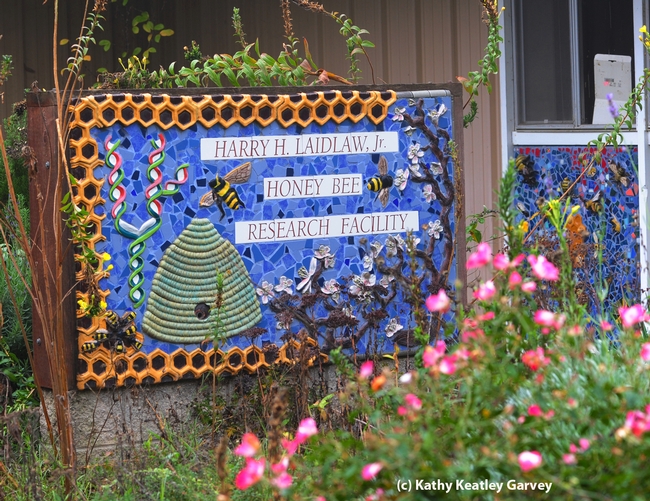


- Author: Kathy Keatley Garvey
"Almonds are one of the first crops of the season that need bee pollination," tweeted the Almond Board of California yesterday.
Valentine's Day traditionally marks the beginning of almond pollination season, but it's an early spring. The almonds are blooming and the bees are buzzing.
So, first the tweets, then the buzzes.
CNN Money, New York, came out Feb. 7 with a news story headlined "Honeybee Die-Off Shouldn't Sting." The Almond Board linked to it in its tweet.
The piece, written by Steve Hargreaves, explored the "good news and bad news on the honeybee beat."
Hargreaves said that colony collapse disorder (CCD) continues to claim about 30 percent of the nation's bees every winter. That's the bad news. The good news, he said, is that "beekeepers have been able to rejuvenate their hives each year so that by summer, the population is back to previous levels."
And "another bit of good news," Hargreaves pointed out, is that although agricultural yields are rising and "rejuvenating beehives is costly," the higher costs aren't being transferred in the supermarket.
Hargreaves quoted UC Davis agricultural economist Daniel Sumner as saying "It shouldn't be a significant item on the radar screen of consumers. It's not that big of a deal."
So, there you have it. Bees are in trouble. Almond production is up (about 750,000 acres in California and each acre requires two hives for pollination). And, demand for almonds is up. California now produces 80 percent of the world's almonds.
Meanwhile, honey bee guru and Extension apiculturist Eric Mussen of the UC Davis Department of Entomology, is repeatedly asked "How are the bees doing?" He writes a bi-monthly from the UC Apiaries newsletter and the periodic Bee Briefs, both posted on the Department of Entomology website.
Mussen attributes CCD (a mysterious malady characterized by adult bees abandoning the hive) to a combination of factors, including parasites, pesticides, pests, diseases, malnutrition and stress.
It continues to amaze us, however, what some folks think is causing CCD. They're looking for a silver bullet. There is none.
The arguments can get ugly. As debates continue to rage in the CNN Money commentary section, one reader, obviously exasperated, posted "...the writers in this place don't know anything about the realms of science, economics or ecology. And 90 percent of the posters aren't very bright, either."
Meanwhile, the bees are busy pollinating almonds.
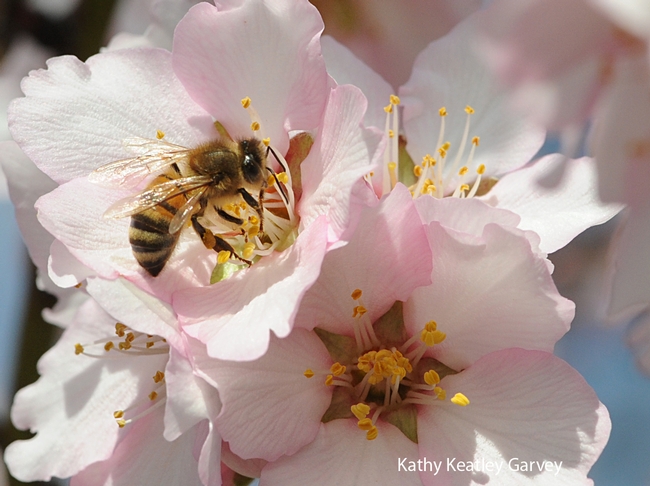
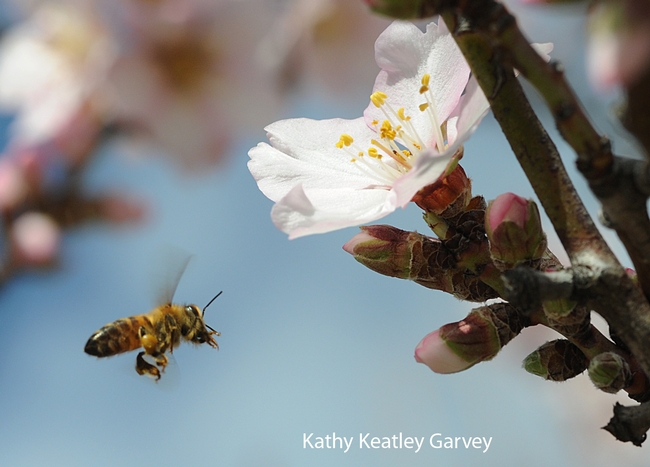
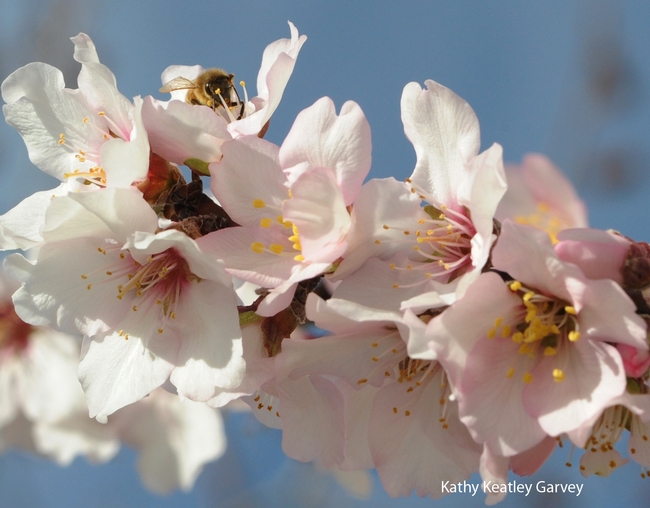
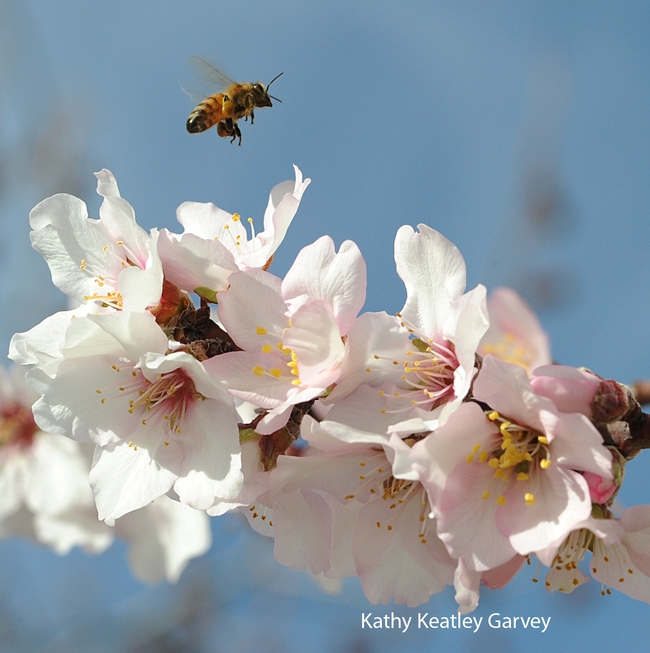
- Author: Kathy Keatley Garvey
Growing almonds isn't all it's cracked up to be.
It's expensive.
The next time you're enjoying a ice cream bar coated with almonds or a salad with toasted almonds, think not only about the honey bees, but the growers.
The Almond Board of California recently reported that "Despite the higher yields and increased efficiencies California almond growers have gained over the years, the costs associated with growing almonds have risen dramatically while net returns per acre have shrunk."
A study by Cooperative Extension Specialist Karen Klonsky of the UC Davis Agricultural and Resource Economics showed that the total cost of producing an acre of almond is $3,897.
Yes, one acre.
Klonsky analyzed costs for an assumed 40-acre orchard in the northern San Joaquin Valley with 16-foot-22-foot spacings, 124 trees per acre, microsprinkler irrigation, and a 25-year orchard life.
The cultural costs totaled $1,752 or 45 percent of the total cost of production.
Cultural costs? Think pruning, weed control, pickup and ATV use, pollination, irrigation and fertilization, disease, and pests (insects and gophers).
Pollination--that would be the honey bees--accounted for $280 per acre or 16 percent of the cultural costs. (California has some 750,000 acres of almonds, and each acre requires two hives for pollination.)
Overall, next to cultural costs, the cost of land proved to be the second-highest expense, followed by production costs, cost of trees, and equipment.
"Applying this cost scenario to a price of $1.90 per pound, Klonsky calculated the break-even point would require a 2000 pound-per-acre yield," the board reported in its March newsletter.
And you thought growing almonds was easy?
